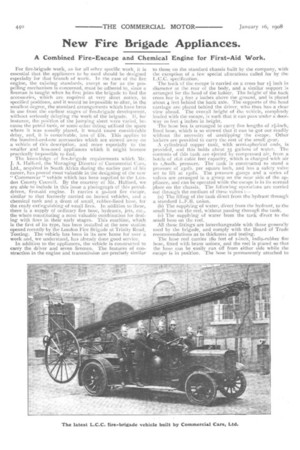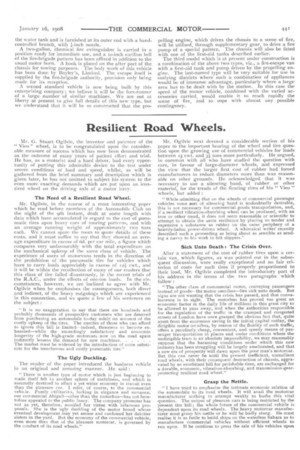New Fire Brigade Appliances.
Page 16

Page 17

If you've noticed an error in this article please click here to report it so we can fix it.
A Combined Fire-Escape and Chemical Engine for First-Aid Work.
For fire-brigade work, as for all other specific work, it is essential that the appliances to be used should be designed especially for that branch of work. In the case of the fire engine, the existing standards, except so far as the propelling mechanism is concerned, must be adhered to, since a fireman is taught when he first joins the brigade to find the accessories, which are required at very short notice, in specified positions, and it would be impossible to alter, in the smallest degree, the standard arrangements which have been in use from the earliest stages of fire-brigade development, without seriously delaying the work of the brigade. If, for instance, the position of the 5uraping sheet were varied, because the petrol tank, or some other fitting utilised the space where it was usually placed, it would cause considerable delay, and, it is conceivable, loss of life. This applies to the hundred-and-one accessories which are stowed away on a vehicle of this description, and more especially to the smaller and less-used appliances which it might become practically impossible to find.
The knowledge of fire-brigade requirements which Mr. J. A. Halford, the Managing Director of Commercial Cars, Ltd., acquired in South Africa during the earlier part of his career, has proved most valuable in the designing of the new " Commercar " vehicle which has been supplied to the London County Council. By the courtesy of Mr. Halforcl, we are able to include in this issue a photograph of this petroldriven, -first-aid engine. It carries a 50-foot fire escape, similar to that formerly carried on horsed vehicles, and a chemical tank and a drum of small, rubber-lined hose, for the ready extinguishing of small fires. In addition to these, there is a supply of ordinary fire hose, hydrants, jets, etc., the whole constituting a most valuable combination for dealing with fires in their early stages. This machine, which is the first of its type, has been installed at the new station opened recently by the London Fire Brigade at Trinity Road, Tooting. The vehicle has been in its new home for over a week and, we understand, has already done good service.
In addition to the appliances, the vehicle is constructed to carry the driver and seven firemen. The features of construction in the engine and transmission are precisely similar to those on the standard chassis built by the company, with the exception of a few special alterations called for by the L.C.C. specification.
The back of the escape is carried on a cross bar i inch in diameter at the rear of the body, and a similar support is arranged for the head of the ladder. The height of the back cross bar is 3 feet 2 inches above the ground, and is placed about 4 feet behind the back axle. The supports of the head carriage are placed behind the driver, who thus has a clear view ahead. The overall height of the vehicle, completely loaded with the escape, is such that it can pass under a doorway so feet 4 inches in height.
The hose box is arranged to carry five lengths of 1.-.inch, lined hose, which is so stowed that it can be got out readily without the necessity of unshipping the escape. Other lockers are provided to carry the rest of the small gear.
A cylindrical copper tank, with semi-spherical ends, is provided, and this holds about 35 gallons of water. The contents of this tank are ejected by compressed air, from a bottle of 16.6 cubic feet capacity, which is charged with air to 1,800lb. pressure. The tank i8 constructed to stand a pressure of 2501b, per square inch, and has a safety valve set to lift at 15o1b. The pressure gauge and a series of valves are arranged in a group on the near side of the appliance, and can be operated while the escape is in its normal place an the chassis. The following operations are carried out through the medium of these valves :—
(a) The filling of the tank direct from the hydrant through a standard L.F.B. union.
(b) The supplying of water, direct from the hydrant, to the small hose on the reel, without passing through the tank.
(e) The supplying of water from the tank direct to the small hose on the reel.
All these fittings are interchangeable with those generally used by the brigade, and comply with the Board of Trade recommendations as to thickness and testing.
The hose reel carries 18o feet of s-inch, india-rubber fire hose, fitted with brass unions, and the reel is placed so that the hose can be easily run off from either side while the escape is in position. The hose is permanently attached to the water tank and is furnished at its outer end with a handcontrolled branch, with ,4-inch nozzle.
A two-gallon, chemical fire extinguisher is carried in a position ready for immediate use, and a to-inch carillon bell of the fire-brigade pattern has been affixed in addition to the usual motor horn. A hook is placed on the after part of the chassis for towing purposes. The body work of this vehicle has been done by Bayley's, Limited. The escape itsel.f is supplied by the fire-brigade authority, provision only being made for its reception.
A second standard vehicle is now being built by this enterprising company ; we believe it will be the fore-runner of a large number of similar machines. We are not at liberty at present to give full details of this new type, but we understand that it will be so constructed that the pro pelling engine, which drives the chassis to a scene of fire, will be utilised, through supplementary gear, to drive a fire pump of a special pattern. The chassis will also be fitted with one of the first-aid tanks described earlier.
The third model which is at present under construction is a combination of the above two types, viz., a fire-escape van with a first-aid tank and pump driven by the propelling engine. The last-named type will be very suitable for use in outlying districts where such a combination of appliances would be of immense advantage, particularly where a large area has to be dealt with by the station. In this case the speed of the motor vehicle, combined with the varied accessories carried, would enable it to reach rapidly the scene of fire, and to cope with almost any possible contingency.




















